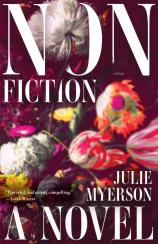Nonfiction
Review
Nonfiction
After reading NONFICTION, you may want to look up Julie Myerson to learn more about her and her book. Or maybe you will do so before you even begin delving into this work of fiction. Either way, you will find articles both critical of and sympathetic towards Myerson’s use of her own life and that of her children in her novels. That blurring of lines between real life and imagination is just one of the themes --- but perhaps the key one --- in NONFICTION, as the title may lead you to note.
This story, as in some of Myerson’s previous work, seems to dovetail with her experiences in just the ways she has been called out for over the years. Critics and book clubs will have much to ponder and discuss if they so choose, and of course Myerson knows this. NONFICTION, however, stands up as a good book: thoughtful, painful, meticulously written and emotional yet never saccharine.
"[NONFICTION is] a heartbreaking family tale and a strong piece of writing. It examines marriage, fidelity, motherhood, the creative impulse and addiction, all with a keen eye and a delicate heart."
The unnamed narrator is a writer whose only child is a heroin addict. Often living on the streets or crashing in the most unsafe places, the teenage daughter lies, steals and prostitutes herself for drugs. Her parents don’t always know where she is and if she’s alive or dead. When she comes to them, it is often for money or a place to stay for just a few awful days. They send her to rehab and do their best to care for her without enabling her, but much is out of their control.
The teen’s mother loves her yet is sometimes disgusted by her, and the guilt she experiences is immense and complicated. She believes herself to have been a terrible mother. She carried on a long affair, prioritized her writing career, and was distracted by her own childhood trauma. Torn between her daughter and her mother, her husband and her lover, her professional life and her family obligations, she is caught, indeed, between fiction and nonfiction.
As the narrator parses out the truths of her past, she constantly worries about her daughter. The love she has for her includes fear and anger, worry and impatience. It gives NONFICTION an emotional heft that counterbalances the easy pacing and clear, even brisk, narrative style. This is an intense and challenging book but is never too much work to read.
Myerson is well aware of the ways in which readers, including her own family members, have found her novels to have cut too close to the bone of her biography. The narrator plays with this tension as well. Past the halfway mark, an emerging writer working with the narrator asks her about a previous book. “I know it's a novel, but it didn’t feel like one,” she says. “It felt more like a memoir --- something about how direct it was --- it almost felt like a confession at times.” Towards the end of the novel, the narrator addresses this even more directly, considering her writing to be “a kind of fiction which could not possibly have been written were it not for the real things that happened to her in her real life.”
There is no need to know anything about Myerson, her family or her past work to appreciate NONFICTION. It is, all on its own, a heartbreaking family tale and a strong piece of writing. It examines marriage, fidelity, motherhood, the creative impulse and addiction, all with a keen eye and a delicate heart.
Reviewed by Sarah Rachel Egelman on January 6, 2024
Nonfiction
- Publication Date: January 2, 2024
- Genres: Fiction
- Paperback: 240 pages
- Publisher: Tin House Books
- ISBN-10: 1959030310
- ISBN-13: 9781959030317



